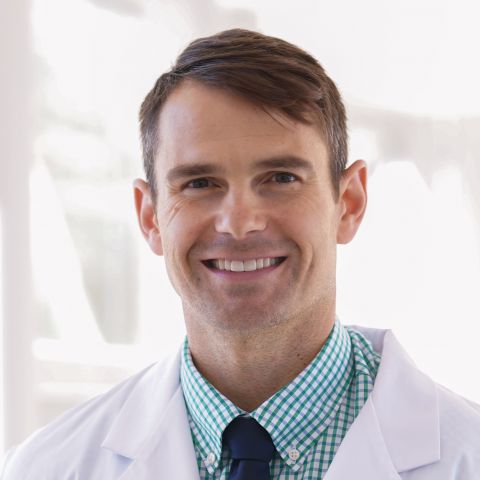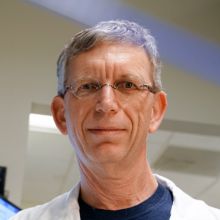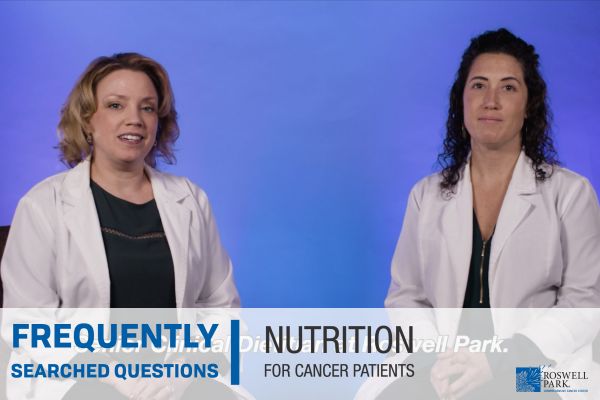A new treatment strategy designed at Roswell Park Comprehensive Cancer Center aims to deliver a one-two punch to airway tumors that threaten a patient’s ability to breathe — and a phase 2 clinical trial will evaluate how well it works. One group of patients enrolled in the study will follow a ketogenic (keto) diet three days before and three days after undergoing a specialized type of photodynamic therapy (PDT), while the other group will receive PDT alone.
The dietary part of the study may sound surprising until you learn about the science behind it. Originally developed in the 1920s to treat patients with epilepsy, and more recently touted as a way to combat obesity, the keto diet is limited to foods that are very low in carbohydrates, high in fat, and moderate to low in protein. It’s based on the principle that when the body doesn’t have enough carbohydrates to burn, it forces the mitochondrion — the part of the cell that acts as an energy source — to switch over and burn fat instead.
But that’s how the diet affects healthy cells. “The mitochondria in tumor cells don’t have that ability to switch over,” says Nathaniel Ivanick, MD, FCCP, Director of the Interventional Pulmonary Service at Roswell Park and principal investigator of the clinical trial. It’s hoped that by cutting off the carbohydrate supply to the tumor mitochondria, the keto diet will weaken them before PDT delivers a second blow to destroy them altogether.
While there is some evidence that a keto diet can improve the effectiveness of chemotherapy and radiation therapy, Roswell Park is the first institution to explore its potential in combination with PDT, notes Dr. Ivanick. A few years ago, after reading about the effects of a keto diet, he sat down with Gal Shafirstein, DSc, MSc, Director of PDT Clinical Research and a member of the Cell Stress Biology Department at Roswell Park, to talk about adding the diet to the PDT regimen to see if that approach would boost the effectiveness of PDT. “He got excited about it,” says Dr. Ivanick.
PDT is already FDA-approved for treating lung cancer in the airway, he notes. If the addition of a keto diet shows promise, it could provide substantial relief to the 30% of lung cancer patients who develop airway-obstructing tumors. The clinical trial also is open to patients with other cancers that have metastasized to the airway.
When a tumor inside the airway or pressing on it from the outside grows large enough to prevent air from passing easily into the lungs, breathing becomes increasingly difficult and often brings cancer treatments to a halt. “The life expectancy of these patients is fairly low without aggressive intervention,” explains Dr. Shafirstein. “Because shortness of breath and the sensation of struggling to breathe produce such profound difficulty and anxiety in patients, opening the airway might be enough so they can get their next dose of palliative radiation or chemotherapy that otherwise they would be too ill to get.”
How does photodynamic therapy work?
Photodynamic therapy, a treatment developed at Roswell Park, begins with an infusion of a nontoxic drug called a photosensitizer, which accumulates in the tumor. Afterward, the tumor is exposed to laser light delivered through optical fibers. The light activates the drug, killing the cancer cells and destroying the blood vessels that help the tumor survive. Some studies suggest that it may also stimulate the immune system to track down and kill cancer cells in other parts of the body.
Because the photosensitizer is nontoxic, PDT can be used along with any other standard cancer treatments and repeated as often as needed. The main side effect is a strong sensitivity to light, which lasts from a few days to a few months.
Over the years, Roswell Park researchers have refined the treatment, coming up with new photosensitizers and finding ways to enable the laser light to reach tumors even deeper in the body. Tumors inside the airway require interstitial PDT (I-PDT), a technique in which the optical fibers are inserted directly into the tumor. They remain in place only while the laser light is administered.
A new way to deliver I-PDT
The Roswell Park research team has developed a new computer-guided I-PDT technique that uses an endobronchial ultrasound (EBUS) system — a flexible scope equipped with a video camera and ultrasound — to guide the optical fibers through the airway for more precise placement into the tumor. They were able to first test the idea thanks to a gift of $250,000 from Kenneth and Paula Koessler and the Kenneth L. and Katherine G. Koessler Family Foundation. “Their kind donation made it possible to start this research,” says Dr. Shafirstein.
A phase 1 study found that computer-guided I-PDT was a promising new approach. Results of that phase of the study, published in the June 26, 2022, issue of JTO Clinical and Research Reports, concluded that the method was “safe and potentially beneficial in increasing overall survival.”
Now the larger phase 2 study will evaluate its efficacy in patients either with or without the keto diet. Only one group of patients will adopt the six-day keto diet. Because medical conditions may prevent some patients from following the diet — and some patients might not want to follow it — those who enroll in the clinical trial will be able to choose whether to join Group A (I-PDT alone) or Group B (I-PDT plus the keto diet). Roswell Park will arrange for frozen keto meals to be delivered to the homes of patients in Group B, and members of the Nutrition and Food Services team will educate and advise those patients during the study.
“This is pretty novel,” says Dr. Ivanick. “We’re trying to solve problems with new and different therapies, and I think that’s science at its best.”
Learn more about this clinical trial.
NOTE: “A ketogenic diet is recommended only for specific health reasons, under very specific circumstances,” cautions Linda Leising, BS, RD, CDN, Senior Clinical Dietitian at Roswell Park. “Even if you attempt this diet for a medically appropriate reason, it could be harmful for people with some pre-existing medical conditions. Consult your doctor before starting a ketogenic diet.”




